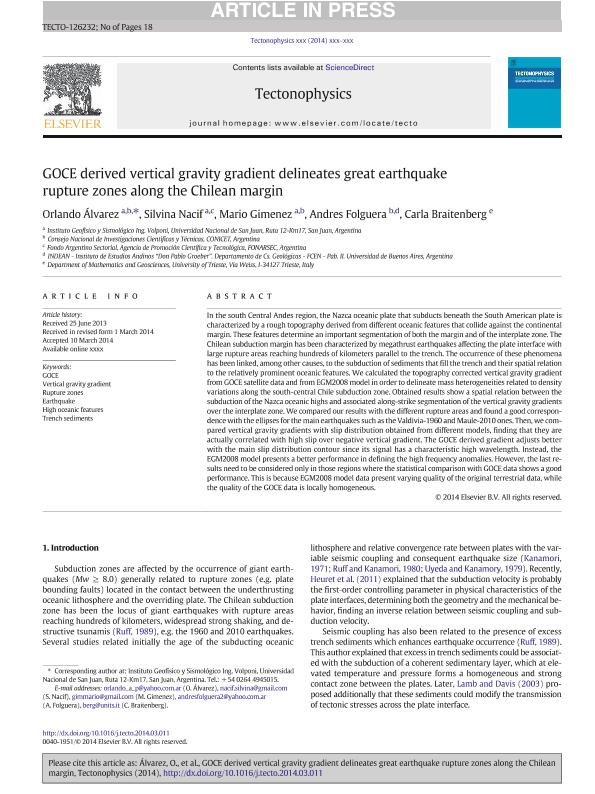Mostrar el registro sencillo del ítem
dc.contributor.author
Alvarez Pontoriero, Orlando

dc.contributor.author
Nacif Suvire, Silvina Valeria

dc.contributor.author
Gimenez, Mario Ernesto

dc.contributor.author
Folguera Telichevsky, Andres

dc.contributor.author
Braitenberg, Carla
dc.date.available
2016-04-18T20:53:27Z
dc.date.issued
2014-03
dc.identifier.citation
Alvarez Pontoriero, Orlando; Nacif Suvire, Silvina Valeria; Gimenez, Mario Ernesto; Folguera Telichevsky, Andres; Braitenberg, Carla; GOCE derived vertical gravity gradient delineates great earthquake rupture zones along the Chilean margin; Elsevier; Tectonophysics; 622; 3-2014; 198-215
dc.identifier.issn
0040-1951
dc.identifier.uri
http://hdl.handle.net/11336/5265
dc.description.abstract
In the south Central Andes region, the Nazca oceanic plate that subducts beneath the South American plate is characterized by a rough topography derived from different oceanic features that collide against the continental margin. These features determine an important segmentation of both the margin and of the interplate zone. The Chilean subduction margin has been characterized by megathrust earthquakes affecting the plate interface with large rupture areas reaching hundreds of kilometers parallel to the trench. The occurrence of these phenomena has been linked, among other causes, to the subduction of sediments that fill the trench and their spatial relation to the relatively prominent oceanic features. We calculated the topography corrected vertical gravity gradient from GOCE satellite data and fromEGM2008 model in order to delineate mass heterogeneities related to density variations along the south-central Chile subduction zone. Obtained results show a spatial relation between the subduction of the Nazca oceanic highs and associated along-strike segmentation of the vertical gravity gradients over the interplate zone.We compared our results with the different rupture areas and found a good correspondence with the ellipses for the main earthquakes such as the Valdivia-1960 andMaule-2010 ones. Then, we compared vertical gravity gradients with slip distribution obtained from different models, finding that they are actually correlated with high slip over negative vertical gradient. The GOCE derived gradient adjusts better with the main slip distribution contour since its signal has a characteristic high wavelength. Instead, the EGM2008 model presents a better performance in defining the high frequency anomalies. However, the last results need to be considered only in those regions where the statistical comparison with GOCE data shows a good performance. This is because EGM2008 model data present varying quality of the original terrestrial data, while the quality of the GOCE data is locally homogeneous.
dc.format
application/pdf
dc.language.iso
eng
dc.publisher
Elsevier

dc.rights
info:eu-repo/semantics/openAccess
dc.rights.uri
https://creativecommons.org/licenses/by-nc-nd/2.5/ar/
dc.subject
Rupture
dc.subject
Zones
dc.subject
Satelital
dc.subject
Gravimetry
dc.subject.classification
Física Atómica, Molecular y Química

dc.subject.classification
Ciencias Físicas

dc.subject.classification
CIENCIAS NATURALES Y EXACTAS

dc.title
GOCE derived vertical gravity gradient delineates great earthquake rupture zones along the Chilean margin
dc.type
info:eu-repo/semantics/article
dc.type
info:ar-repo/semantics/artículo
dc.type
info:eu-repo/semantics/publishedVersion
dc.date.updated
2016-05-06 15:52:43.262787-03
dc.journal.volume
622
dc.journal.pagination
198-215
dc.journal.pais
Países Bajos

dc.journal.ciudad
Amsterdam
dc.description.fil
Fil: Alvarez Pontoriero, Orlando. Universidad Nacional de San Juan. Facultad de Ciencias Exactas, Fisicas y Naturales. Instituto Geofisico Sismologico Volponi; Argentina. Consejo Nacional de Investigaciones Científicas y Técnicas; Argentina
dc.description.fil
Fil: Nacif Suvire, Silvina Valeria. Universidad Nacional de San Juan. Facultad de Ciencias Exactas, Fisicas y Naturales. Instituto Geofisico Sismologico Volponi; Argentina. Agencia de Promoción Científica y Tecnológica. Fondo Argentino Sectorial; Argentina
dc.description.fil
Fil: Gimenez, Mario Ernesto. Universidad Nacional de San Juan. Facultad de Ciencias Exactas, Fisicas y Naturales. Instituto Geofisico Sismologico Volponi; Argentina. Consejo Nacional de Investigaciones Científicas y Técnicas; Argentina
dc.description.fil
Fil: Folguera Telichevsky, Andres. Consejo Nacional de Investigaciones Científicas y Técnicas. Oficina de Coordinación Administrativa Ciudad Universitaria. Instituto de Estudios Andinos; Argentina
dc.description.fil
Fil: Braitenberg, Carla. Universita Degli Studi Di Trieste; Italia
dc.journal.title
Tectonophysics

dc.relation.alternativeid
info:eu-repo/semantics/altIdentifier/doi/10.1016/j.tecto.2014.03.011
dc.relation.alternativeid
info:eu-repo/semantics/altIdentifier/url/http://www.sciencedirect.com/science/article/pii/S0040195114001395
dc.relation.alternativeid
info:eu-repo/semantics/altIdentifier/doi/http://dx.doi.org/10.1016/j.tecto.2014.03.011
Archivos asociados
